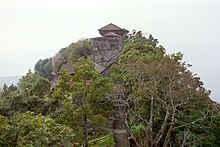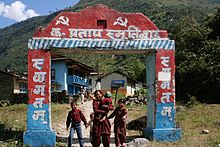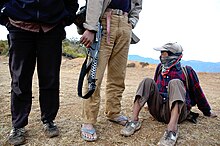History of Nepal
The history of Nepal encompasses the developments in the area of the Federal Republic of Nepal from prehistory to the present.

Early history
Nepal's history is shaped by the influence of India and China . A part of the traditions of the earlier national history of Nepal is very often associated with myths and legends. Archaeological finds from the Stone Age around 30,000 BC. In the region around the temple complex of Budhanilkantha the first traces of settlement of the Kathmandu valley can be proven. However, there is no verifiable continuity to the current population and the early settlers.
In the early days , the valley in which today's capital Kathmandu is located was a large mountain lake. After this had disappeared due to an earthquake , numerous people immigrated from the surrounding areas and united to form the mixed people of the so-called Newar . The valley was fertile and farming was easy, which led to the development of great skills in the handicrafts among the population, which were known throughout East Asia.
In some early traditions, such as the Indian Sanskrit epics , such as the Upanishads , Brahmanas and Puranas , Nepal is not mentioned with any syllable. In the most famous Indian epic Mahabharata , however, the country in the Kathmandu Valley is mentioned as "Kiratadesa". The name is probably derived from the rulers of the Kiratas dynasty, who lived there from around 700 BC. Should have ruled.
In the seventh century in the Empire of China, the pagoda style developed by the Nepalese from the Kathmandu valley, which also spread in Japan . Nepalese master craftsmen were well known and in demand. At this time, Buddhism began to spread in Nepal, but could never prevail over Hinduism .
Formation of Nepal

After Nepal had been under Indian Rajput rule for a long time, the Newar Jayadharma Malla finally managed to unite and liberate the valley in the 14th century . His grandson, Yakasha Malla , was later able to expand the territory even further and thus ensure great prosperity in his kingdom. His four sons, however, divided the country again among themselves and thus weakened it in all respects.
Due to this weakening almost incapable of war, the area of Nepal was forcibly unified as the Kingdom of Gorkha in 1768 under the Gurkha prince Prithvi Narayan Shah (r. 1742–1775) . Narayan's policy of expansion collided with the interests of the British East India Company . The territorial disputes led to the Anglo-Nepalese Gurkha War in 1814 , which ended with the Sugauli Treaty in 1816, according to which Nepal ceded Sikkim and the Terai , allowed a permanent British resident in Kathmandu, and gave the British the right to recruit Nepalese soldiers. Through the treaty, Nepal was formally a British protection state , but in domestic matters it remained de facto independent.
Kingdom of Nepal

As early as 1846, Jang Bahadur Rana brought himself to power through a bloody massacre and introduced a new system of government, according to which the office of prime minister was hereditary. The king (from 1911 Prithvi Bir Bikram Shah Dev's son Tribhuvan Bir Bikram Shah Dev ) only nominally retained his power, the respective prime minister was the sole ruler. The ruler's course was already showing signs of isolation from neighboring countries at this time, with the only exception being that politics was always friendly towards the British, albeit emphatically aloof.

As early as August 3, 1914, the then Prime Minister Chandra Shamsher made soldiers available to the British for Gurkha units , even before the official declaration of war on the First World War . By the end of the war, Nepal provided the Army of British India with a total of 55,000 Gurkha soldiers who fought for Great Britain in Afghanistan, in the Ottoman Empire , but also in Europe. An official declaration of war was not made.
The country also provided troops later in the Anglo-Afghan War of 1919 and in World War II , making it clear that it was an “independent ally”. As a result, Nepal's diplomatic relations were enormously upgraded and complete sovereignty was ensured, which enabled Nepal from the British side to establish diplomatic contact with other states, which was initially only used hesitantly.
The formal recognition of the royal dignity of the Ranas , for example by India, continued to fail. For this reason, too, but mainly under pressure from returning war veterans, Prime Minister Padma Shamsher announced a new, relaxed constitution in 1948, but before it was introduced he was overthrown by the military under Mohan Shamsher . In 1950, King Tribhuvan, hoping to restore his royal dignity, went to India, where riots broke out on the border shortly afterwards.
The Ranas initially had the upper hand militarily, but to prevent China from taking advantage of the political unrest in Nepal to enforce its annexation claims, India intervened and forced the Ranas and the king to compromise to re-establish a constitutional monarchy . Both the Ranas and the opposition Nepali Congress received part of the power in parliament. Active and passive women's suffrage became law in 1951,
The Nepali Congress, however, quickly broke up into smaller parties struggling for power. The political unrest was intensified in the following years by floods and famine, so that King Tribhuvan declared a state of emergency in 1952 and gained dictatorial sole power. After the death of his father in 1955, Mahendra Bir Bikram Shah Dev took power. This was forced in 1959 by the Nepali Congress to hold free parliamentary elections, which the Congress clearly won.
The new Prime Minister Bishweshwar Prasad Koirala undertook ambitious reforms to combat the backwardness of Nepal, even if a larger part of the state power was now reserved for the king. But he did not have much success, as early as 1960 the king the autocracy in the form of a historically unprecedented Hindu - monarchy reintroduced and all political parties strictly prohibited.
Two years later, the constitution was expanded to include the so-called Panchayat system , which introduced a kind of village self-government through local councils, the Panchayats. Parliament continued to be elected, with 112 members directly elected by the people and 28 others appointed by the king. This parliament in turn elected the Prime Minister.
Formally, the king was now only the head of the executive , but with his right of veto he could make all relevant decisions alone. His foreign policy was directed principally towards India and China, and he obtained economic aid from Beijing of £ 7.5 million . King Mahendra's son, Birendra Bir Bikram Shah Dev, did not change the constitution either, although he was initially expected to be more open to Western democracy.
In the following years stagnation prevailed , apart from the expansion of the infrastructure and the communication system there was no particular progress. The economic and social situation deteriorated further, and Nepal remained dependent on extensive development aid , mostly from Germany . In 1980 demonstrators forced a national vote on the Panchayat system, but this was just confirmed with 55% of the vote.
In 1990 the multi-party system was reintroduced (under pressure from the democracy movement supported by India, which was supported by the urban middle class and students), and Nepal became a constitutional monarchy.
The first democratic elections took place in May 1991. Within a very short time, however, the new political elite was even more corrupt than the old government in the eyes of the population.
End of the monarchy
King Birendra was murdered in June 2001 in a massacre committed by his son, Crown Prince Dipendra Bir Bikram Shah Dev . Birendra's brother Gyanendra Bir Bikram Shah Dev became king and declared himself absolute ruler in 2005 (until 2006). After a general strike in April 2006, parliament was reinstated and a seven-party government was formed. In the transitional constitution, all the political prerogatives of the king were transferred to the prime minister.
On December 28, 2007, the transitional parliament voted with more than two thirds of the votes in favor of an amendment to the transitional constitution which de facto meant the abolition of the monarchy. A majority of 270 of the 329 MPs were in favor of a federal democratic republic as the form of government.
The constituent assembly gave formal confirmation of the king's disempowerment in its constituent session on May 28, 2008. The assembly proclaimed the republic with an overwhelming majority. The elections for the constituent assembly on April 10, 2008 had resulted in a surprising landslide victory for the Maoists, which, however, missed an absolute majority.
On July 21, 2008, Ram Baran Yadav was elected the first President of the Republic of Nepal.
Civil War and Current Developments
From 1996 to 2006 the Communist Party of Nepal (Maoist) was in a civil war against the monarchy and the Hindu class system. The insurgents were branded as terrorists after September 11, 2001 . More people died in the internal political conflict within the next six months than in the previous six years.
Parliament was dissolved on May 22, 2002, and Prime Minister Sher Bahadur Deuba let the mandate of the elected self-governing bodies expire. On October 4, 2002, King Gyanendra dismissed his prime minister for "incompetence". On October 11, 2002, a new interim government was appointed. The major parties NC, CPN-UML and parts of the RPP, however, refused to participate in the new government because there was no democratic legitimation.
The new Prime Minister Lokendra Bahadur Chand ( RPP ) promised to end the confrontation with the Maoists. A compromise was not in sight, however, as the government strictly refused to change the political structure.
Only a few media, such as the magazine Himal, reported critically and informatively on both sides. The brutality of the Maoists has often been spoken of; in fact, they used drastic measures against the army and the police. The latter were also not squeamish in their crackdown on the Maoists and, on suspicion, proceeded against civilians who were believed to be sympathizers or supporters of the Maoists, or even made them disappear.
An estimated two thirds of the dead were caused by the army and police. Only a few western journalists reported on the Maoists, who in the meantime represented a decisive power factor in the country. At the end of 2002, they ruled 55 of the 75 districts of Nepal.
More than 12,700 people were killed in the guerrilla war. The fighting had increased again in August 2003. From August 18, 2004, the Maoists had even completely cut off the capital from the outside world for a few days or cut important overland connections. After the failure of the peace talks and the end of the armistice, several hundred were killed again. However, tourists were able to move around relatively freely and safely - since they are one of the country's most important sources of income, they are treated politely on all sides. Officially, a tourist was indirectly killed by a bomb explosion.
“Unity in the fight against terrorism” was the government's slogan. Colin Powell visited Nepal in January 2004 and promised help. The Nepalese government was interested in weapons and armaments. On February 1, 2005, King Gyanendra brought some movement back into the political game. He declared a state of emergency and dismissed the entire government. Prime Minister Deuba and other members of the government were placed under house arrest.
Gyanendra accused Deuba of failing as he failed to reach an agreement with the Maoists in view of the next election. Gyanendra promised to restore law and order in the country and to reinstate democracy within three years, but the Maoists and a large part of the population feared that he would not give up his power again anytime soon. Deuba said the king's actions violate the constitution and are anti-democratic. Both the UN and Nepal's most important allies, India, the USA and Great Britain, criticized the king's behavior. Some countries, including Germany and France, briefly withdrew their ambassadors.
From April 7, 2006, a general strike called by the alliance of all seven parties represented in the dissolved parliament and supported by large parts of the people raged across the country.
After more than two weeks of the general strike with daily demonstrations by hundreds of thousands of people across Nepal, the signs increased that the king's power was declining. The brutal police crackdown on the peaceful demonstrators had meanwhile cost at least 13 lives, hundreds injured and thousands arrested.
Due to the large protests and international pressure, especially from India, King Gyanendra announced on April 21, 2006 in a televised address to the nation that he would now put the executive power back into the hands of the people. The seven-party alliance was expressly authorized to appoint the next prime minister. The latter rejected the king's offer as too little: it continued to demand the reinstatement of the parliament, which was dissolved in 2002, the convening of a constituent assembly and the restriction of the king's absolutist rule and called for further mass demonstrations.
Under pressure from monarchist circles as well as international pressure - among other things, the USA feared a strengthening of the Maoists, who now controlled almost 80% of Nepal - King Gyanendra finally felt compelled on April 24, 2006 to declare in a televised address the immediate re-establishment of the former parliament . The opposition then declared the general strike over.
On May 18, parliament passed a resolution that was adopted unanimously, making far-reaching changes to the state order: King Gyanendra therefore lost command of the military and only performed representative tasks, but could no longer exercise any influence on state affairs. He also lost his immunity from prosecution and had to pay taxes from then on. Furthermore, Nepal decided on the same day to become a secular state, which means: Hinduism is no longer the state religion .
On May 26, the new government under Prime Minister Girija Prasad Koirala started peace talks with the Maoist rebels. Several hundred imprisoned rebels have previously been released and constitutional reform has been suggested. The aim was to end the civil war that had been going on for ten years.
On November 21, 2006, the agreement to end the ten-year civil war was signed by Prime Minister Koirala and Maoist leader Prachanda .
The earthquake in Nepal on April 25th in 2015 set the country's development far back. Over 7,000 people died, and cultural assets and infrastructure were badly damaged.
Until the founding of provinces by the constitution of 2015, the administrative structure of Nepal consisted of five developing regions .
literature
- Johannes Winter, Matthias Becker: Tourism and internal conflicts in Nepal - political ecology as a conceptual basis for evaluation . In: H. Faust, T. Reeh, K. Gee (eds.): Leisure and tourism - conceptual and regional studies from a cultural-geographic perspective . Duehrkohp & Radicke, Göttingen 2004, ISBN 3-9809276-1-X , p. 161–182 (ZELTForum - Göttingen writings on landscape interpretation and tourism, 2).
- Jürgen C. Aschoff: Tibet, Nepal and the cultural area of the Himalaya . with Ladakh, Sikkim and Bhutan. Annotated bibliography of German-language books from 1627 to 1990 (essays up to 1900). Garuda, Dietikon / Schweiz 1992, ISBN 3-906139-07-7 (Also in the Internet Archive ( Memento from November 2, 2005 in the Internet Archive ) (Version from November 2, 2005)).
- Thomas Benedikter: War in the Himalayas. Background to the Maoist uprising in Nepal. A political geography . LIT Verlag, 2003, ISBN 3-8258-6895-8 .
- Dor Bahadur Bista: Fatalism and Development. Nepal's Struggle for Modernization . Patna 1991.
- Kanak Mani Dixit, Shastri Ramachandaran (Ed.): State of Nepal . Kathmandu 2002.
Web links
- Database of literature on the social, political and economic situation in the history of Nepal
- Nepal's history - overview on bilder-aus-nepal.de
- Asian Human Rights Commission - Human Rights in Nepal
- University of Cambridge: Digital Nepal , 2001 census data, maps, ethnographic materials (including digitized journals), digitized copies of rare books and manuscripts
- Nepal Research. Website on Nepal and Himalayan Studies. nepalresearch.org
- Nepal at suedasien.info
Individual evidence
- ↑ http://www.cosmorama.de/nepal/nep.info.htm
- ^ Madan Kumar Bhattarai: Diplomatic history of Nepal, 1901–1929. A critical appraisal of Nepal-British India relations. New Delhi 1990, ISBN 8185304114 , p. 33.
- ^ Mart Martin: The Almanac of Women and Minorities in World Politics. Westview Press Boulder, Colorado, 2000, p. 272.
- ↑ report at eKantipur.com ( Memento of 30 December 2007 at the Internet Archive )
- ^ Dpa Deutsche Presse-Agentur GmbH: Monarchy abolished in Nepal , from May 28, 2008
- ↑ Yadav prevails against Maoist candidates in Nepal on July 21, 2008
- ^ Report of the Rheinischer Merkur (no longer available) ( Memento of August 13, 2004 in the Internet Archive )
- ↑ Ed Douglas. "Inside Nepal's Revolution ... .. (just to check .. !!!)". National Geographic Magazine, p. 54, November 2005. Douglas lists the following figures: "Nepalis killed by Maoists from 1996 to 2005: 4,500. Nepalis killed by government in same period: 8,200."
- ^ Report of the Peace Research Group at the University of Kassel ( Memento from February 5, 2004 in the Internet Archive )
- ↑ Earthquake in Nepal: Helpers save four buried victims - after eight days . Spiegel Online May 3, 2015


